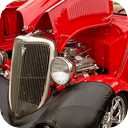(short preview of full seamless looping track)
(short preview of full seamless looping track)
(short preview of full seamless looping track)
(short preview of full seamless looping track)
(short preview of full seamless looping track)
Hot Rods
This product is not available in the selected currency.
In Stock
Backordered
Out of Stock
Description
The strong yellow sun glimmers off of the miles of chrome being polished and admired on this fine day. Tires turn beneath behemoth engines, grinding into the pavement, leaving trails of black boiling tar behind them. The gangs of onlookers hoot and holler, cheering on their favorite souped up roadster as it prepares to battle some posers impractical piece of garbage. Your eyes begin to blur and tear, and you think you must be getting nostalgic, but then you realize it's from the exhaust and smoke of burnt rubber. Hot rods are typically American cars with large engines modified for linear speed. The origin of the term "hot rod" is unclear. One explanation is that the term is a contraction of "hot roadster," meaning a roadster that was modified for speed. Another possible origin includes modifications to or replacement of the camshaft(s), sometimes known as a "stick" or "rod". A camshaft designed to produce more power is sometimes call a "hot stick" or, here, a "hot rod". Roadsters were the cars of choice because they were light. The term became commonplace in the 1930s or 1940s as the name of a car that had been "hopped up" by modifying the engine in various ways to achieve higher performance. The term seems first to have appeared in the late 1930s in southern California, where people would race their modified cars on the vast, empty dry lake beds northeast of Los Angeles under the rules of the Southern California Timing Association (SCTA). The activity increased in popularity after World War II, particularly in California because many returning soldiers had been given technical training in the service. Many were prepared by Bootleggers in response to Prohibition to enable them to avoid revenue agents ("Revenooers"); some police vehicles were also modified in response.
Opps
Sorry, it looks like some products are not available in selected quantity.



